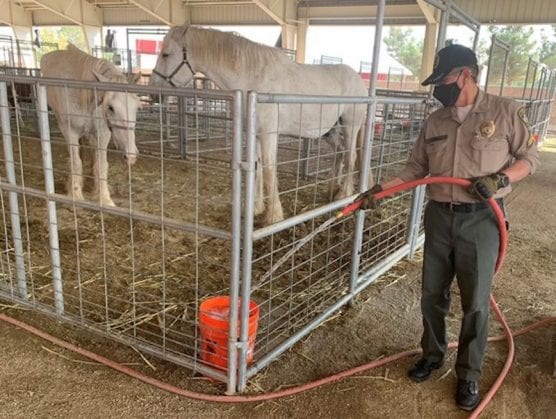The Los Angeles County Department of Animal Care & Control (DACC) is continuing its emergency animal sheltering services for residents displaced by the devastating Lake Fire, which has burned more than 31,000 acres in the Santa Clarita and Antelope valleys of northern Los Angeles County.
The Ranch Fire near Azusa has been burning as well, causing further evacuations. Additionally, approximately 12,000 lightning strikes have started 585 fires in California over the past week, burning more than one million acres. There is no end in sight for these current wildfires, and more than 13,000 firefighters are battling the fires across California to protect lives and property.
These recent events underscore the importance of having an emergency plan that includes your pets. Because many people must evacuate at a moment’s notice, this plan should be completed and ready to implement immediately. Here are things pet owners should do to ensure their beloved companions are protected:
For dogs, cats, and small companion animals compile an evacuation kit that contains the following information (your pets should already be wearing ID and license tags):
– Copies of vaccine records, especially rabies
– Copies of pet licensing records
– Microchip information, including the pet’s microchip ID number and the issuing company (make sure your information is current with the company – many people move and forget to update the company with their new contact information).
– A list of all medications taken by your pet, with a week’s supply in the kit. Note the diagnosis/reason the pet takes the medication in case someone else must provide the care.
– Flea and tick medication
– Five days’ worth of pet food
– Collapsible food and water containers
– Extra leashes/harnesses
– A collapsible crate to safely confine your pet to protect it from harm
– Toys, blankets, treats, and other items to comfort your pet in a strange environment
– Clear photographs of your pet, including full body pictures from both sides and a close up of their face.
For horses and livestock:
– Make certain your trailer is safe and functional. Perform a complete safety check, including the flooring, frame, welds, axle, brakes, lights, hitch, interior safety and tires. Do this now, before you must move your animals.
– Ensure your horses or other livestock will quickly and obediently load. There have been unfortunate cases of animals left behind because owners were not able to load them into the trailers for evacuation.
– Include copies of vaccinations, especially Strangles, Equine Infectious Anemia, and West Nile virus for horses.
– DACC encourages the microchipping of horses and livestock, not only to identify them if they become lost or evacuated without identification but also to reduce the threat of livestock theft. Microchip your livestock and keep the microchip records up to date, with copies in your evacuation kit.
– Lists of all medications, special feed, medical issues, or other needs your animals may have.
– Have clear photographs of your animals, both full bodied from both sides as well as of any brands, ear tags, ear notches, or other identifying information.
– If you are evacuating livestock from threat of fire, do not place any shavings, straw, or other bedding in the trailer because sparks can fly into the trailer and ignite the bedding. For the same reason, do not put blankets on your horses when evacuating from fires.
– Bring fly masks, fly sheets, halters and lead ropes, and other items for your animals’ comfort.
– Many people will identify their horses by writing their phone numbers on the horses’ hooves, or
attaching an equine-specific safety neck band with identifying information. This is a good supplement to the microchip.
DACC responds regularly throughout the year to provide animal evacuation and sheltering services. Our dedicated staff and volunteers work 24 hours a day to provide for the comfort and safety of evacuated animals. We view this as an honor to be able to serve the people and animals of Los Angeles County.
Evacuations are not always the result of wildfires. Mudslides, train derailments, toxic emissions, and other man-made disasters can cause emergency evacuations even in non-fire prone areas. Can your pets and animals count on you for their emergency preparedness?
Like this:
Like Loading...
Related





 Tweet This
Tweet This Facebook
Facebook Digg This
Digg This Bookmark
Bookmark Stumble
Stumble RSS
RSS




























REAL NAMES ONLY: All posters must use their real individual or business name. This applies equally to Twitter account holders who use a nickname.
0 Comments
You can be the first one to leave a comment.